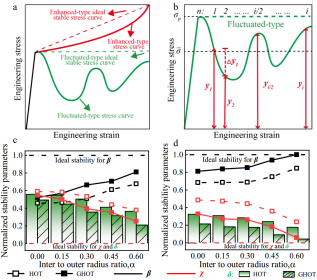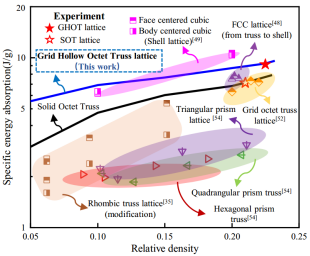Address: No. 92, Xidazhi Street, Nangang District, Harbin



JOIN-USHIT sincerely invite talents from both home and aproad to join in the new course of constructing first-class universities. |
Recently, the research group led by Tan Huifeng at the center for composite materials and structure of school of astronautics has made significant progress in controlling the stress stability of lattice materials during their nonlinear phase. The relevant results have been published under the title 'Grid hollow octet truss lattices that are stable at low relative density' in the prestigious solid mechanics journal, the Journal of the Mechanics and Physics of Solids. This research quantitatively evaluates the stability of low relative density metamaterials and proposes three validated metrics that enhance the stiffness, strength, and SEA of the original structure, providing new solutions to address the issue of unstable buckling responses in lattice materials at low relative densities.

Fig.1 Strategies for designing lightweight lattice materials with excellent and stable mechanical properties.
The lattice materials, through the perfect integration of topology-optimized structures and lightweight characteristics, offer a groundbreaking solution to the pressing demand of modern industry for high-strength and high-stiffness structural materials. However, in the process of expanding towards lower densities, lattice materials have long encountered critical technological barriers, where their topology-optimized structures exhibit significant local buckling as relative density decreases, leading to an unsteady buckling response of the material system at the critical low-density threshold. Thus, the urgent question persists: can nonlinear stability be achieved at lower relative densities? In response, Professor Tan Huifeng's team has proposed a viable solution by combining hollow structures with grid distribution structures, referred to as the grid hollow octet lattice (GHOT). It demonstrates a highly stable nonlinear compressive response at low relative densities, and to quantitatively assess the stability of metamaterials with low relative density, three verification measures have been introduced, revealing the formation mechanism of stress stability during the nonlinear phase.
At low relative densities, the deformation is primarily governed by local or global buckling behavior, resulting in a compressive stress-strain curve that is predominantly fluctuated-type stress curve, which impacts the energy absorption efficiency. Consequently, a quantitative assessment of its nonlinear stability is essential. Stability will be quantitatively evaluated using three parameters: average plateau stress ratio (β), fluctuation coefficient (χ), and improved standard deviation (δ).

Fig.2 (a) Fluctuated-type and enhanced-type stress–strain curves, along with the corresponding ideal stress curve. (b) Parameters used in the formulas for stability metrics. The expression for the stability parameter of the stress–strain curve for GHOT and HOT lattices at relative densities of (c) 0.05 and (d) 0.10




The paper further compares GHOT with other excellent lattice materials. Compared to other well-known truss, tubular, and shell structures, GHOT exhibits superior energy absorption efficiency at low and moderate relative densities. Its specific energy absorption (SEA) values are advantageous compared to shell lattices, and its nonlinear response is more stable, surpassing other lattice structures.

Fig.3 Comparison of the proposed GHOT lattice with other conventional bending-dominated and stretching-dominated truss and shell lattices in terms of nonlinear stability

Fig.4 Ashby charts of specific energy absorption for the proposed structure and other energy-absorbing structures with respect to relative density
Harbin Institute of Technology (HIT) is listed as the first affiliation on the paper, with the first author being Zhang Peijie, a doctoral student from the school of astronautics. Associate Professor Chen Xueyan and Professor Tan Huifeng from Harbin Institute of Technology are the corresponding authors of the paper. The graduate student Yu Penghui participated in the related research work. This research was supported by the scientific fund of t the Science Foundation of National Key Laboratory of Science and Technology on Advanced Composites in Special Environments and the National Natural Science Foundation.
Original article link:
https://www.sciencedirect.com/science/article/pii/S0022509625000444